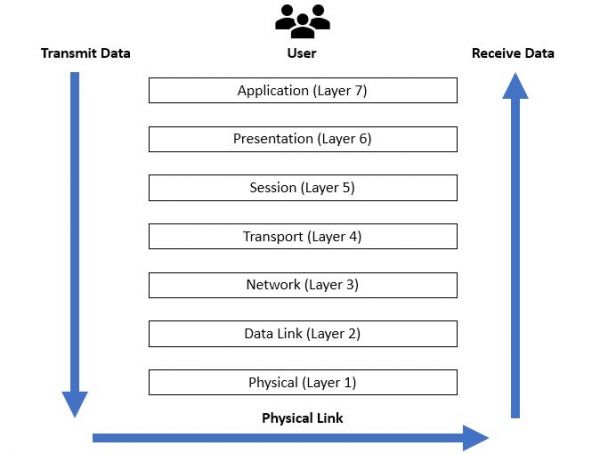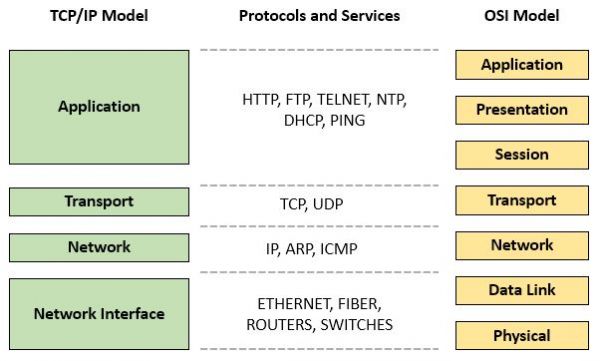OSI Model & TCP/IP Model
Contents
OSI Model
OSI Model - Open Systems Interconnection Model. It is a conceptual model that characterizes and standardises the communication functions of a telecommunication or computing system without regard to its underlying internal structure and technology. The OSI model can be seen as a universal language for computer networking.
The Seven Layers of the OSI Model
Application Set
7. Application Layer - Layer that interacts with the OS or application whenever the user chooses to transfer files, read messages, or perform other network-related activities.
6. Presentation Layer - Takes the data provided by the application layer and converts it into a standard format that the other layers can understand. Translates between applications and network formats.
5. Session Layer - Establishes, maintains and ends communication with receiving device. i.e. continuous exchange of information in the form of multiple back-and-forth transmissions between two nodes.
Transport Set
4. Transport Layer - Maintains flow control of data and provides for error checking and recovery of data between the devices. Flow control means that the Transport layer looks to see if data is coming from more than one application and integrates each application’s data into a single stream for the physical network. Also provides the ack of successful data transmission and sends the next data if no errors occurred.
- Segmentation/desegmentation - segmentation is the process of dividing a long message into smaller msgs)
- Error control (checksum)
- Although not developed under the OSI Reference Model/not strictly conforming to the OSI definition of the transport layer, the Transmission Control Protocol (TCP) and the User Datagram Protocol (UDP) of the Internet Protocol Suite are commonly categorized as layer-4 protocols within OSI.
3. Network Layer - The way the data will be sent to the recipient device is determined in this layer. Logical protocols, routing, and addressing are handled here. (IP) 2. Data Link - The appropriate physical protocol is assigned to the data. Also, the type of network and the packet sequencing is defined. This layer provides note to node data transfer, a link between two directly connected nodes. Defines the protocol for flow control. MAC and LLC layer.IEEE 802 divides the data link layer into two sublayers:[5]
- Medium access control (MAC) layer – responsible for controlling how devices in a network gain access to a medium and permission to transmit data. Pretty much its to provide an addressing mechanism so nodes on the same network can communicate to each other.
- Logical link control (LLC) layer – responsible for identifying and encapsulating network layer protocols, and controls error checking and frame synchronization. Error correction (Yes, Transport layer 4 also has error checking.. It adds an error checksum to the header)
- Point-to-Point Protocol (PPP) is a data link layer (layer 2) communications protocol used to establish a direct connection between two nodes. It connects two routers directly without any host or any other networking device in between. It can provide connection authentication, transmission encryption,[1] and compression.
1. Physical Layer - This is the level of the actual hardware. It defines the physical characteristics of the network such as connections, voltage levels, and timing. Transmission and reception of raw data between devices and a physical transmission medium.
OSI is just a guideline, actual protocol stacks often combine one or more of the OSI layers into a single layer.
Protocol Stacks - a group of protocols that all work together to allow software or hardware to perform a function. I.e. TCP/IP Model.
(Difference between TCP and LLC: https://learningnetwork.cisco.com/thread/101366 )
TCP/IP Model
TCP/IP Model - Transmission Control Protocol/Internet Protocol. The TCP/IP Model is a concise version of the OSI model. It contains four layers, unlike seven in the OSI model. The Internet protocol suite is the conceptual model and set of communications protocols used in the Internet and similar computer networks. It is commonly known as TCP/IP because the foundational protocols in the suite are the Transmission Control Protocol and the Internet Protocol.
The Four Layers of the TCP/IP Model in Comparison with OSI Model
4. Application Layer - Combines Session (5), Presentation (6), and Application (7) layers of the OSI. Protocols for email (SMTP), (FTP)
3. Transport Layer - Same as Transport (4) layer. Where TCP works by asking another device on the network if it is willing to accept info from the local device. Also UDP can be found here.
2. Internet Layer - Corresponds to the Network (3) layer. Internet Protocol (IP) uses IP addy, consisting of a Network Identifier and a Host Identifier, to determine the addy of the device it is communicating with.
1. Network Interface/Data Link Layer - Combines Physical (1) and Data link (2) layers and routes the data between devices on the same network. It also manages the exchange of data between the network and other devices.
Example of TCP/IP Model
4. User interacts with browser, sends request for: www.site.com. Application sends this message/request to the TCP program at the transport layer. Source: xxx.yyy.zzz. TCP is responsible for error-free delivery of the message to the destination host. (It will let the application program know if it cannot deliver the message for some reason).
3. TCP program adds header information to the message. Includes the address of source and destination, and an error checksum. And port info in this case its port 80. The TCP program then passes the message plus its new header to the IP program at the network/internet layer.
2. IP program adds another header, which contains only the information the routers need to deliver the packet to the destination host (IP source and dest., and TTL). The packet (larger envelope). At this point TCP has converted the domain names www.site.com and source xxx.yyy.zzz to IP addresses by using DNS (Domain name servers). TTL is the number of router hops the packet should go through before giving up and deciding that it cannot be delivered.
1. Packets are moved within the LAN from sending host to the router, by the hardware, software and firmware, at the Data link and physical layers at the bottom of this protocol stack. Each program in the stack adds its own header. They are removed (envelopes opened) at the receiving end.
What Purpose does the OSI model serve?
- The OSI model offers as a general guideline for developers to use to maintain a level of compatibility.
- The idea behind the OSI model is to provide a framework for both designing networking systems and for explaining how they work. The existence of the model makes it easier for networks to be analyzed, designed, built and rearranged, by allowing them to be considered as modular pieces that interact in predictable ways.
So who benefits from the OSI model?
The History of the OSI Model
- The idea behind the creation of networking standards is to define widely-accepted ways of setting up networks and connecting them together. The OSI was an early attempt to get all the various hardware and software manufactures to agree on a framework for developing various networking technologies.
- The OSI model was intended to serve as the foundation for the establishment of a widely adopted suite of protocols that became what is the internet today.
- TCP/IP rose and won over OSI. The OSI model became a useful tool for explaining the operation of networking in general terms. Helps describe interactions between the components of other protocol suites and even hardware devices.
Benefits of Networking Models
- Networking models provide a framework for breaking down complex internetworks into components that can more easily be understood and utilized. The model defines networking functions as a set of layered, modular components where each is responsible for a particular function, rather than a large complicated whole. This results in better comprehension of network operations, improved performance and functionality, easier design and development, and the ability to combine different components in the way best suited to the needs of the network.
Read more at: http://www.tcpipguide.com/free/t_TheOpenSystemInterconnectionOSIReferenceModel.htm
How could you use the OSI model to assist or shape your troubleshooting steps?
- For your home network?
- Connecting to a website? See above tcp/ip model
- In any network, most of the problems occur at the physical, data link, and network layers. So advisable to start at the physical layer and move up to the application layer.
- Check physical components.Make sure cables are plugged in and devices are working properly. If its a wireless network, excessive signal attenuation and wireless interference are a few common issues (at the physical layer for wireless).
- At data link layer, verify all switch and vlan configs along with the MAC addressing.
- If issue persists, look for IP address conflicts and try to eliminate any duplicate IP addresses. Final step: check the spanning tree protocol (STP) because its vital to managing network loops which can often jam or flood the network.
- In the network layer, most common issues are network addressing and routing issues. Issues can be caused due to damaged/broken network devices, incorrect device configs, network bandwidth, and authentication issues. “Ping” is useful at this layer, a successful ping past the default gateway means that the internet is working properly.
- Transport layer issues usually revolve around ports that are blocked or damaged. Make sure there are no firewalls blocking the TCP/UDP ports. Disable QoS can sometimes fix things.
- No issues (or hardly) occur at the session and presentation layers because both just perform functionalities that complement or enhance the functioning of a network. (less active role out of the OSI model layers).
- Application layer issues involve client-server and service related applications (SMTP, HTTP, POP3, FTP). This is where you will find DNS related issues too. Can fix DNS issues with nslookup. Tcpdump is good too for filtering TCP/IP packets and analyzing network packages.
References:
[+] OSI Model: Open Systems Interconnection Model
https://www.webopedia.com/quick_ref/OSI_Layers.asp
[+] OSI Model (Wikipedia)
https://en.wikipedia.org/wiki/OSI_model
[+] How could you use the OSI model to assist or shape your troubleshooting steps?
http://techgenix.com/network-troubleshooting-osi/

